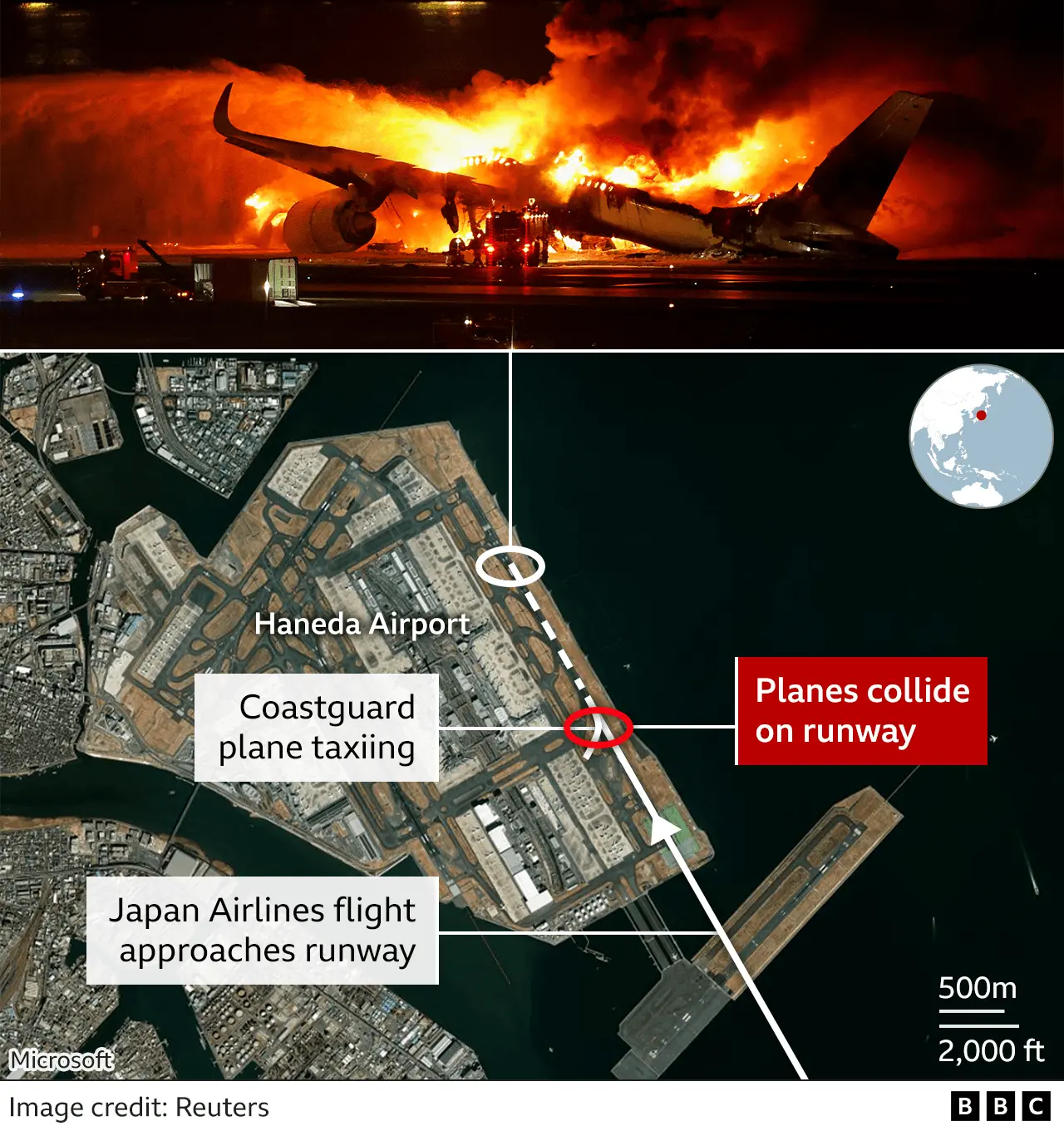Japan Airlines: Hundreds survive after plane bursts into flames on Tokyo runway
A Japan Airlines plane burst into flames after a collision with a smaller coastguard aircraft on the runway at Tokyo's Haneda airport.
All 379 passengers and crew on board were evacuated, but five of the six crew on the coastguard plane died, police said. The captain was injured.
Flames engulfed the airliner after it landed, skidding on the blazing runway.
Fire crews spent hours dousing the blaze. The airliner came from Sapporo on the northern island of Hokkaido.
Air safety experts have praised the crew for safely evacuating all the passengers. All four of Haneda's runways were closed after the incident, disrupting travel plans for thousands of passengers.
Japan Airlines Flight 516 had departed from Sapporo's New Chitose airport at 16:00 local time (07:00 GMT) and landed at Haneda shortly before 18:00.
Video showed it bursting into flames as it sped down the runway after landing.
"I felt a boom like we had hit something and jerked upward the moment we landed," one passenger told Kyodo news agency. "I saw sparks outside the window and the cabin filled with gas and smoke."
Passengers escaped via an evacuation slide and ran across the tarmac to safety, footage and photos showed.
Officials said the flight crew had reported no problems before landing. Exchanges with flight controllers are under investigation.
What caused the collision remains unclear. The coastguard said an investigation was under way to establish how and at what time the two aircraft came into contact with each other.
A Japan Airlines statement said flight JL516 had been "involved in a collision with a Japan coastguard aircraft during its landing at Haneda Airport, resulting in a fire on the runway".
"We want to assure you that all passengers and crew on our flight were safely evacuated. Our thoughts and prayers are with the deceased members of the Japan coastguard."
The coastguard aircraft - a De Havilland Dash 8 turboprop - was heading to help with rescue and relief efforts following Monday's earthquake in Ishikawa. It was one of four planes on a mission to the quake site.
TV footage showed several fire trucks at the scene as smoke and flames billowed from the Airbus. Footage from inside the aircraft showed passengers surrounded by thick smoke. The passenger plane effectively burnt down to its fuselage.
One woman posted a picture of a huge crowd watching the scene unfold. "I was on board. I'm safe. Thank goodness," she wrote on X, the platform formerly known as Twitter.
But within hours of the blaze, police in Tokyo had confirmed reports that the five coastguard crew members had died and said the pilot was severely injured.

Prime Minister Fumio Kishida said the authorities were trying to make sure the accident did not impede deliveries of earthquake relief supplies.
"This is a great regret as the crew members performed their duties with a strong sense of mission and responsibility for the victims of the disaster area," he said.
At least 14 of the passengers and crew who were taken off the Japan Airlines flight suffered minor injuries, according to Japanese public broadcaster NHK, citing fire officials.
Flights at Haneda - one of two international airports serving Japan's capital - were grounded and many diverted to other airports in Japan while emergency services tackled the fire. All but one runway - where the collision took place - opened later on Tuesday evening, the transport ministry said.
It is the first major accident involving an A350, one of a new breed of aircraft built largely of advanced materials such as carbon fibre-reinforced plastic. Airbus is sending a team of specialists to assist in the investigation in Japan.
There was also praise for the efforts of the Japan Airline crew and pilots.
"Their focus is on safety. They are the last people to evacuate the airplane and on face value, it looks like they have done an incredible job," Prof Graham Braithwaite, director of transport systems at Cranfield University in the UK, told the BBC.
